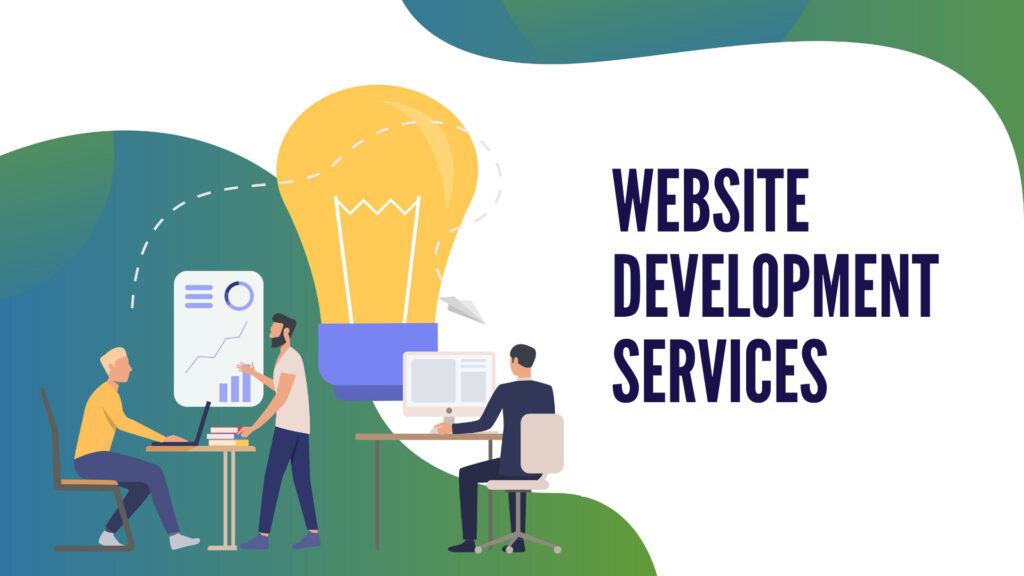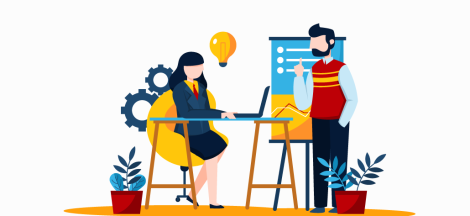Website Development is a hot topic today. Businesses need a functional website or application that caters to customers’ digital needs. No matter what industry they are in, almost all businesses focus on creating a website that is attractive and effective for marketing their services.
The website development process doesn’t just involve coding. There are many aspects to consider, so it is important to have a well-structured process in place to avoid any problems.
The web app development lifecycle is a strategic approach to achieving top-notch results. Create a distinctive website, there are seven phases to the website Development cycle.
We will discuss all phases of web application development in detail and explain each step in the website development checklist.
What is website Development?
Website Development refers to the creation of websites and web apps that can be used on the internet. You can create a static website or code a web-based content management system.
Software development life cycle or SDLC for website development includes-
The coding of the logic
Incorporating databases and managing user questions
designing user interfaces,
Hosting the website on servers
Maintaining and updating
You can classify each activity in custom web app development into client-side or server-side development.
website Development Layers
Server Side
All the processes behind a website’s backend, or server-side development, are included in the backend. The backend includes the management of servers and databases as well as logical components.
These features are not immediately visible to users. However, without a strong backend team, your website won’t be able to perform any tasks.
Client-Side
This layer is also known as the front end. It mainly deals with the design and presentation of the site. Frontend developers create seamless user experiences through responsive web pages. They use HTML, CSS, and JavaScript. Your website won’t be able to attract customers if it doesn’t have a great user interface.
Full Stack
Full-Stack development is a combination of the frontend as well as the backend. It encapsulates all aspects of website Development. This layer deals with all the tasks and technologies that are involved in website development.
A full-stack engineer can be skilled in UI-UX design, database manipulation, and coding browsers.
These three layers are the life cycle of website Development. This is true for web applications and website development.
It is essential to know the web application development cycle if you are working on a web project with your team.
What is the website Development Life Cycle?
The website development lifecycle covers all stages involved in building a website. This includes the initial idea, coding, designing, and finally deploying it. This is the most important or standard step in building a website.
This document provides a guideline for web developers and project managers to follow to achieve optimal results and minimize errors.
These are the 7 stages of the website Development cycle:
- Research
- Plan
- Design
- Content creation
- Development
- Test
- Maintenance
The 7 Phases of the website Development Lifecycle
Research and Analysis
This is a crucial step in website Development. Gathering information about the client and project is essential to ensure your design and development are on the right track.
Your developers will not be able to provide the best solution if they don’t have a clear understanding of their goals and requirements.
These are some of the most common questions you can ask your clients or yourself during the information-gathering phase.
Purpose:
What’s the purpose of this website?
Which type of website/app is it? Informational, commercial, product- or service-based?
Who are you targeting?
Requirements:
Is there enough demand on the market?
Why do users need your website?
What are the needs of your customers?
What are the requirements that the website must meet?
Expectations:
What do you want the appearance and feel of your home to look like?
What and how much will your website bring in business?
What features can the user expect from this application?
What features do you want to add?
It is crucial to imagine the type of people your website will be reaching during this phase. You should consider their preferences, age, gender, and needs. Then set goals and create requirements elicitation documents. It is often a good idea to conduct surveys and get user feedback about the problems they face and the solutions they seek.
It is important to evaluate your web app ideas and determine if they are feasible and financially viable.
This step is crucial because it will make all other stages of website Development irrelevant and not produce the desired outputs.
Planning and Strategy
Website development plans include strategizing every aspect of the website, including content, technology, and marketing. The information gathered in the final stage is used to inform decisions about the website’s structure and features.
The Planning phase creates a team with each member having a role and delegated tasks.
Before you start creating websites, it is important to decide on the content structure, and wireframe (schematics or rough designs), and choose the technology stack and software design methodology.
Technology stack refers to a collection of web frameworks and programming languages that can be used to create any type of web app.
The Planning phase includes creating a sitemap, setting up timelines, assigning resources, and defining deliverables. Before moving to the Design phase, it is important to determine the branding for your website.
Designing and Wireframing
Web design involves the creation of a website layout. This stage also brings in creative UI/UX designers.
Layout involves creating a rough sketch that may be graphical to give you an idea of the layout. Layouts are used to give clients a visual tour of your content and the base features.
The wireframe created in the final stage is converted into buttons, tabs menus dashboards, dashboards color themes, typography, and graphics to create a website base layout.
Keep in mind your target audience research when designing an interactive website. Your website or application should not be boring. Use graphics, colors, and other media to draw users, but keep your branding and purpose consistent.
Content creation
Content is ultimately the king. No amount of fancy design will help you communicate with your customers or readers if you can’t do so.
The main purpose of the content creation stage is to create a communication channel via the user interface.
Writing content is about providing useful information about your company in an attractive and easy-to-understand manner. The website development process includes creative headlines, calls-to-action, and line editing. Writing, formatting, writing, and updating text are all part of the content writing process.
This phase creates your branding and marketing strategy for your website or web app. You can also define your website’s purpose through content writing.
The only way to communicate with end-users is through content.
Code and Development
The actual building of the website is in the development phase. This stage involves the actual building of the website. This stage is the most difficult part of the entire website development process.
Front-end website development
The web design process begins in the early stages of a website’s development. This allows for interactive elements to be added to the page. Utilizing web frameworks and other development tools, web designers add components and functions to the website’s skeleton.
To create a user-friendly website, the web designer uses HTML, CSS, and generally JavaScript as a scripting language. Bootstrap and Foundation are the preferred frontend development tools for web apps using HTML and CSS.
There are many front-end frameworks available for JavaScript. For more information, please visit our blog about the top front-end frameworks to support website Development.
A mobile-friendly version of your website is a good option if you want to stay current with market trends. It is possible to use mobile-friendly elements on your website or develop a mobile app.
Back-end website Development
This is the phase that involves the development of the actual features for the web app. The front end designs the visual elements and interfaces with the user, while the back end codes the instructions for each element to perform the required functions.
Server-side involves the development of the server-side application, creating databases, writing logic, and integrating client and server-side functions. This stage is where developers use a variety of technologies and programming languages.
Search Engine Optimization (SEO), has been added to the task list of backend developers. These features can help you rank higher in search engines such as Google.
Testing and Quality Assurance
To eliminate bugs from the website, rigorous testing is conducted after it has been developed. Repeated testing methods like Stress, Integration Testing, Load Testing, and Unit Testing are performed by the QA team to ensure that the website app is functional, usable, and performs well.
It is essential to maintain project consistency to create a site that works well and provides seamless user experiences. It is important to test the functionality of all features across all platforms and devices.
You can also add small tweaks like plugins or SEO optimization for a smooth deployment. Developers and Testing Engineers work in a continuous loop until the QA team approves that the website is ready for users.
To avoid losing money or time later, we recommend that you start testing as soon as possible. The QA team can simultaneously develop and wireframe tests. This will ensure that you don’t have to test and develop multiple times and prevent major design changes.
Maintenance and deployment
The website or app can be deployed once it has been approved by the QA team. The File Transfer Protocol allows the app to be hosted on web servers.
The work isn’t done. You can always get feedback from users to see where you need to improve. To make necessary changes, the web app development life cycle is completed.
This is not all that’s important. Regular maintenance and updates are essential to ensure the site works well and attracts new users.
Many times, you can leave the maintenance of your website to a web developer or custom web developer. In such instances, you should not neglect maintenance after deployment.
No matter how small or large the project, every phase of the website Development programming cycle is important.
While coding is an important part of any software development project it is important not to neglect design, content generation, security checklists, or team testing.
The website development lifecycle is a continuous journey that can be improved every day.
Are you curious about the cost of your web project? To estimate your budget, read our comprehensive guide to web app development costs.
Conclusion
Web application development can be a complicated process. To achieve the best results, you need to follow a series of steps. Every company will vary in the website Development timeline. They may add or remove phases depending on their project.
The website development process can be modified according to your project management plan. However, it is essential to gather the right data and plan properly for any website development project.
Do you need a web developer who is dedicated to your needs?
Artoon Solutions can provide expert assistance to you in creating the perfect website.






 How Your SEO will Skyrocket with a SILO-Optimized WordPress Website?
How Your SEO will Skyrocket with a SILO-Optimized WordPress Website?